By Adam Hostetler
The red digital timer above the mirror ticks down and shrieks like a smoke alarm as it finally reaches zero.
“Go, go, go. Keep going! Keep going! Keep going!” barks Viloryi Kim, as the seven young men in front of him continue throwing left and right hooks into the air. The timer resets, counting down once more from 60 seconds. The punchers bounce forward and back on their toes, like children jumping rope.
“Elbow, elbow, elbow,” Kim calls, and like clockwork every elbow is raised higher for the punches that follow.
Clinical white fluorescent lights beam down onto the black, sweat-stained floor of Siberia Boxing Club. The flags from 16 countries hang down from the industrial ceiling, the harsh lights piercing through the thin fabric.
Some late arrivals have joined the class and everyone pairs up to practise their technique. Two-foot pool noodles in muted colours are swung by one partner, while the other bobs and weaves to avoid the blows. Kim is 59 and his wisdom and knowledge of boxing is apparent. Kim observes the students like a professor analyzing a math problem and individually critiques their form.
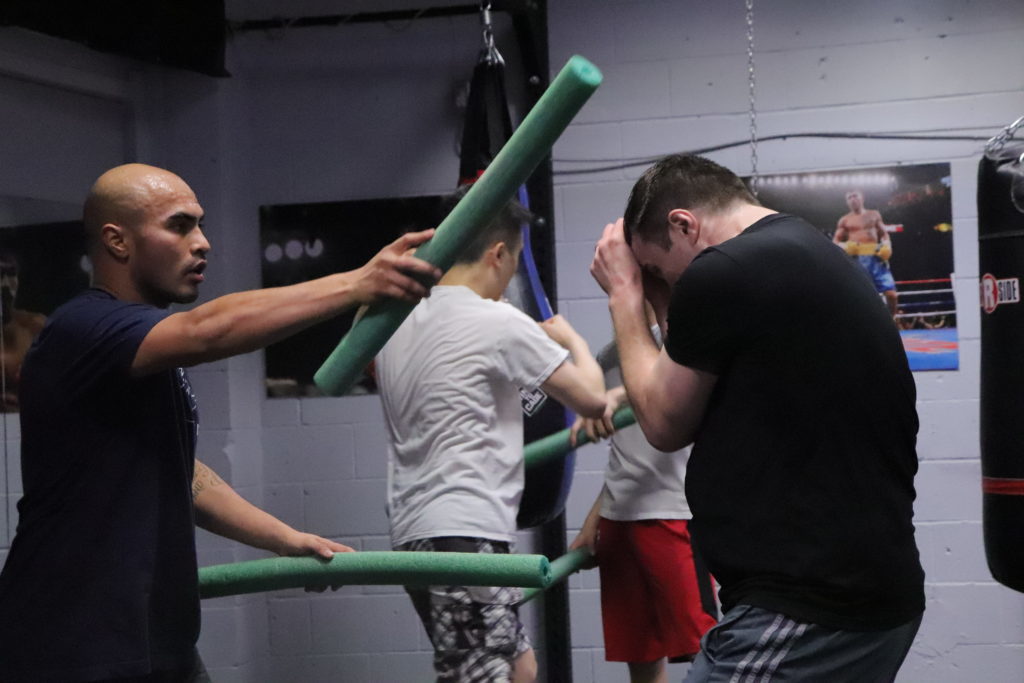
He is the sole coach of Siberia Boxing Club at 177 Dolomite Rd. in North York. He established the gym in 2014, but boxing has been a large part of his life since he was 10 years old growing up in Soviet Kyrgyzstan. Two-thirds of the country lives in rural regions, but his hometown, Bishkek, stands out as the only major city, with a population greater than the next 20 combined.
He did four years of training before entering any professional fights. He says that qualifying for competitions in the Soviet Union is a challenge of its own, in large part due to the sky-high standards and copious contenders. His devotion paid off when Kim successfully made the Kyrgyzstan national team. He would later go on to win the championship of the republic in Kyrgyzstan.
After high school, he went to the Kyrgyz State University of Physical Culture and Sports for four years, graduating in 1982 with a major in boxing. He fought competitively throughout university. After completing his degree at age 21, Kim’s career was at a fork in the road and he had a choice to make.
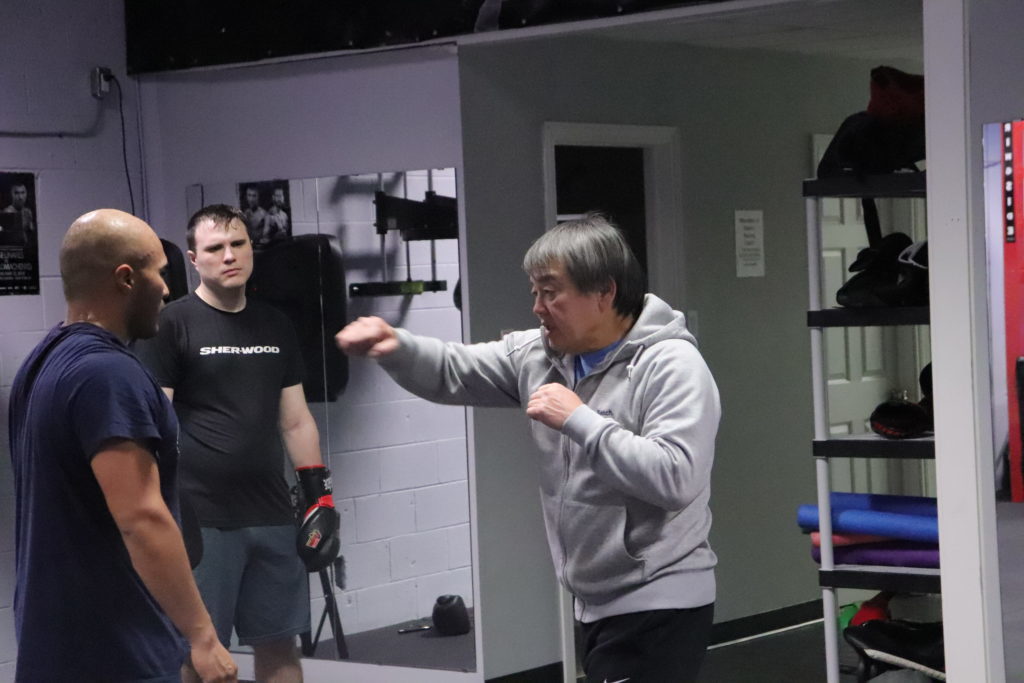
Viloryi Kim instructs Sergei Shishkin (left) and Andres Santana (middle) on the importance of proper punching form. On Wednesday, March 4, 2020. (Adam Hostetler/T•) 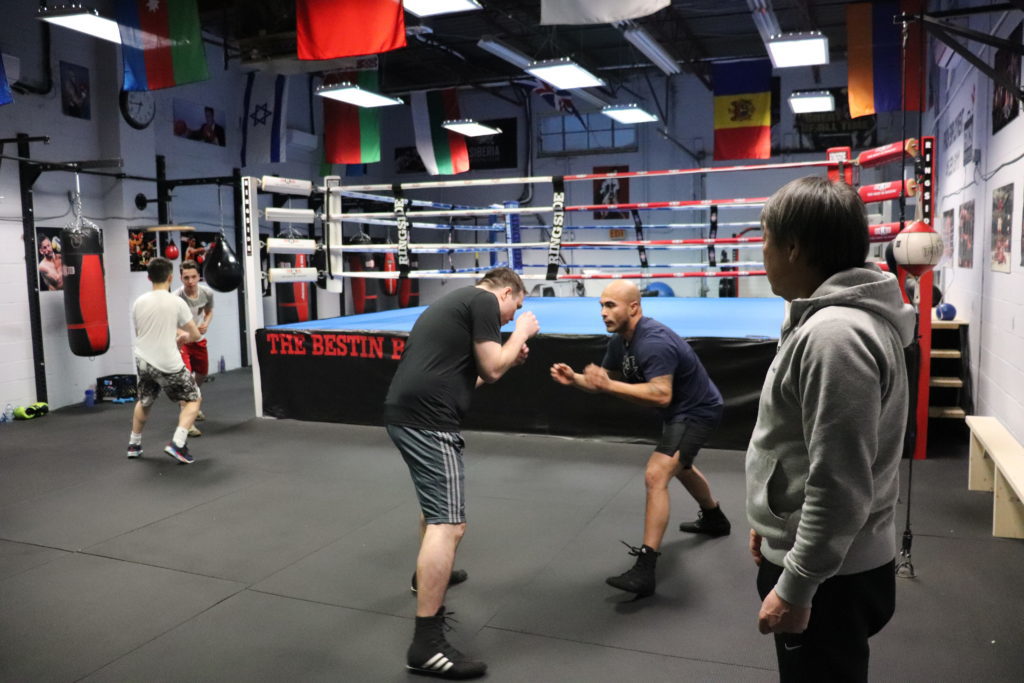
Viloryi Kim analyzes Andres Santana’s (left) and Sergei Shishkin’s (middle) form during a wrestling exercise. On Wednesday, March 4, 2020. (Adam Hostetler/T•) 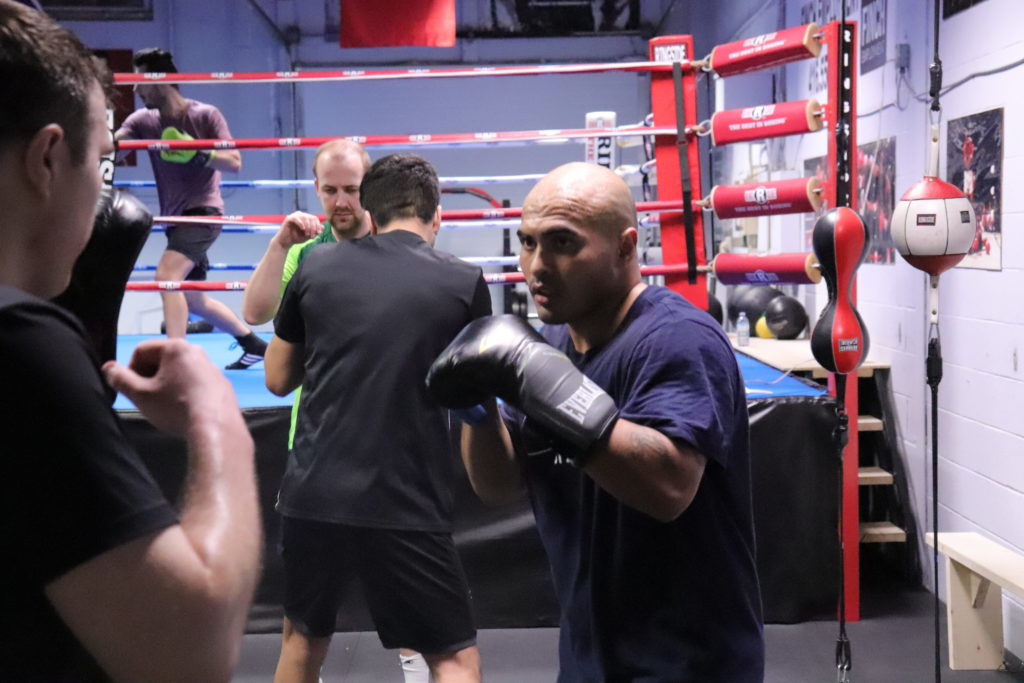
Sergei Shishkin (right) practises his boxing stance and punching form. Coach Viloryi Kim often mentions how vital the elbow is in order to perfect the form. On Wednesday, March 4, 2020. (Adam Hostetler/T•)
“When you’re part of the U.S.S.R. team you’re getting money and getting treated in a way that makes you want to compete. If you’re not on the team, there’s no reason for you to keep competing because there’s no money in it.” Without a spot on the Soviet national team, Kim decided to take his talents outside the ring — and began coaching immediately.
Kim had been able to delay his mandatory draft into the army until he finished university. So for two years following graduation, he was a boxing coach for the Soviet Army in an eastern-Kyrgyzstani military district. That is where Kim achieved what he says is his greatest boxing accomplishment: When he was only 24 years old, two of his students — Dmitry Boliguzov and Vladimir Stepanov — both placed third at the Soviet Union championships.
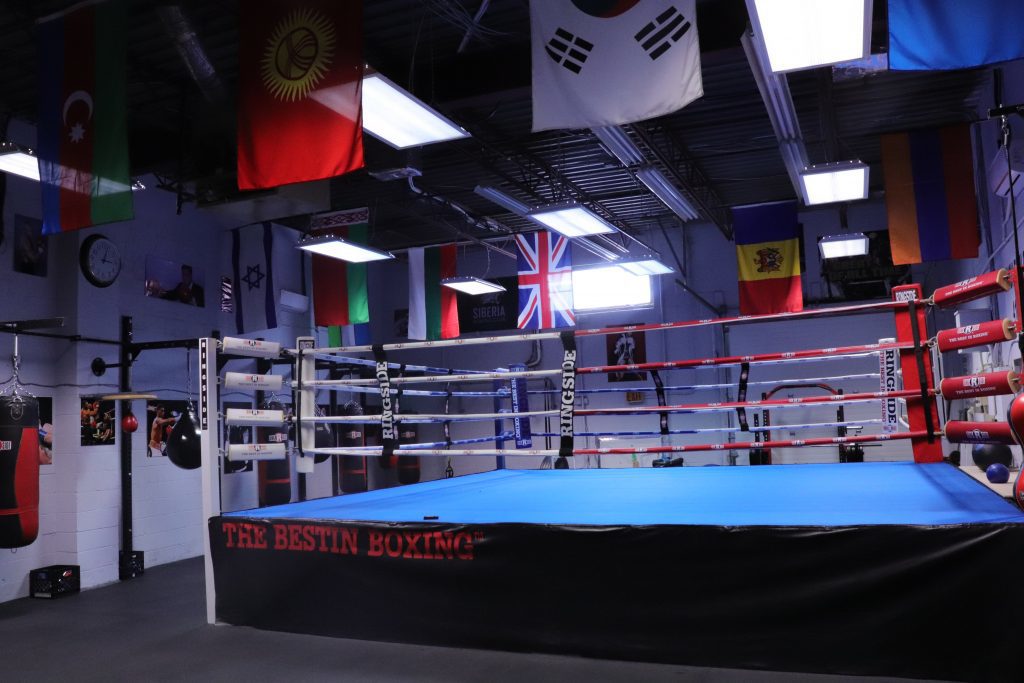
The gym that Kim taught at had members hailing from several teams, including the U.S.S.R. national team, the Russian republic team and the army team. Despite all vying for the same titles and championships, there were no rivalries among the members of coach Kim’s gym. He brought this co-operative-over-competitive mentality overseas when he came to Canada in 2004 and it remains an integral part of his program to this day.
With six other martial arts studios within three kilometres of Siberia Boxing Club, standing out from the competition is crucial. Kim knows he needs a good relationship with his students if he wants more long-term clients. Kim’s daughter, Adele, says students will call her father about life advice.

Most of the training exercises happen in front of the large mirror. This allows the students to see their form and how they can improve upon it. On Wednesday, March 4, 2020. (Adam Hostetler/T•) 
Punching bags and speed bags line the wall. Every square foot at Siberia Boxing Club is utilized and any open space is used for exercises or training. On Wednesday, March 4, 2020. (Adam Hostetler/T•)
Even the gym’s name has origins in an appreciation of community. Kim does not have any direct ties to Siberia, but a lot of the people who helped to fund the gym are from that region. The club’s name is a way for him to pay homage to those who helped him in the past.
This community focus is palpable throughout the gym: the sincere smiles exchanged between students upon arrival, the steady stream of “thanks coach!” Kim hears each night, and the abundant advice shared by advanced fighters. Boruch Rabiski is one of these advanced fighters and has already competed in five professional fights.
“I’ve been to other gyms and this is the best one I’ve tried for sure. Coach critiques each student individually rather than hanging back and only stepping in every so often.”
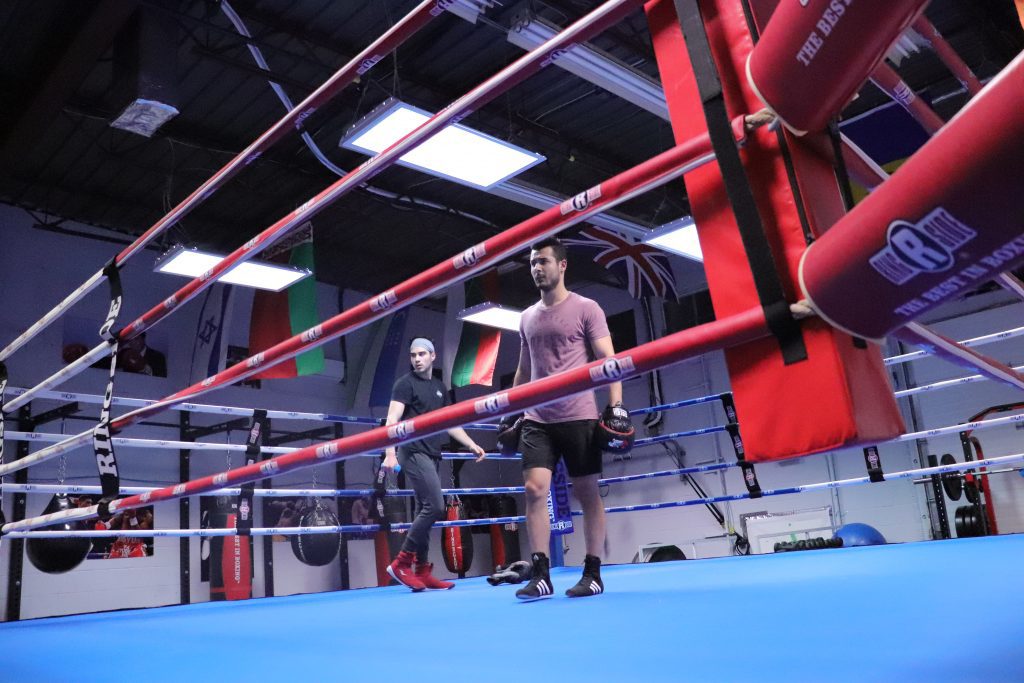
Boruch Rabiski (left) and Samir Mamedov (right) listen attentively to Viloryi Kim’s instructions.
On Wednesday, March 4, 2020. (Adam Hostetler/T•)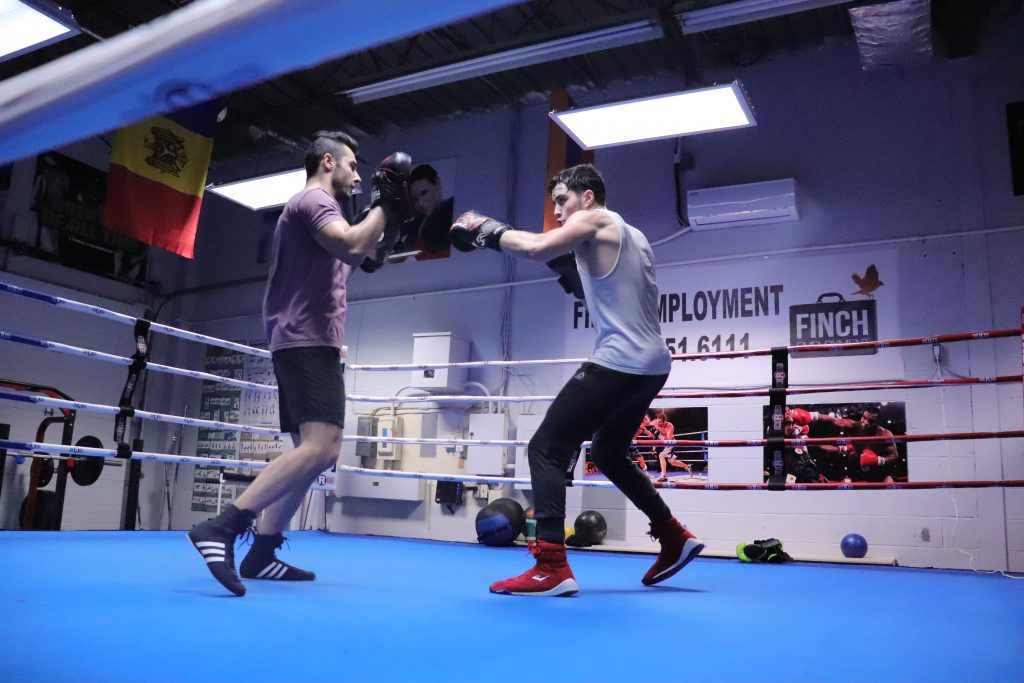
Samir Mamedov (left) holds the boxing pads for Boruch Rabiski (right) as the pair moves around the entire ring. On Wednesday, March 4, 2020. (Adam Hostetler/T•) 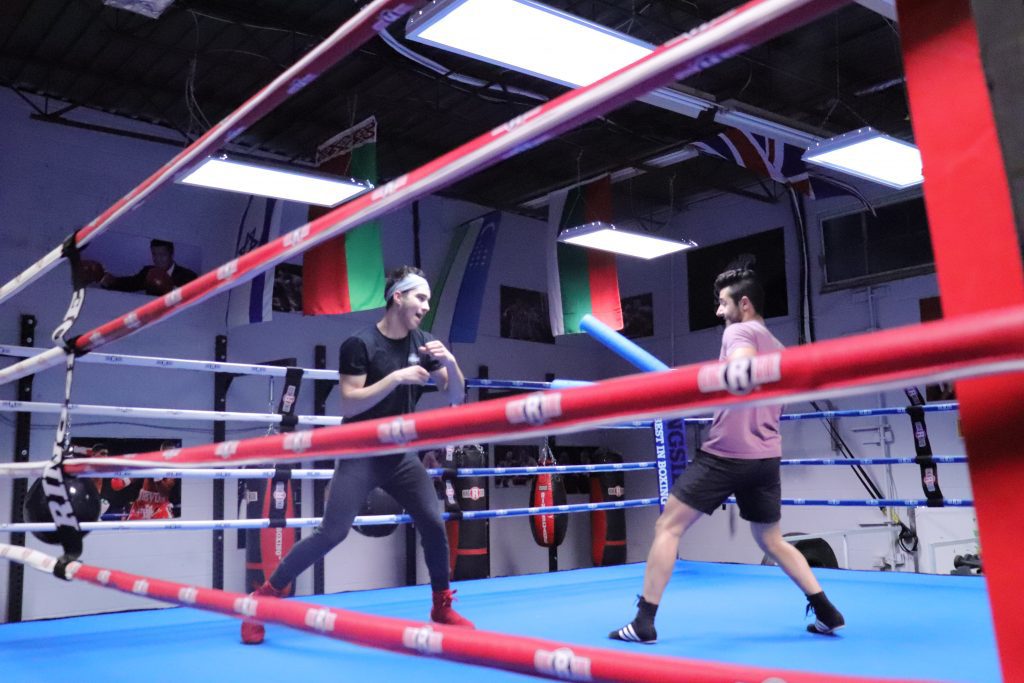
Boruch Rabiski (left) and Samir Mamedov (right) work hard through the practise. The permanent smiles show a genuine love for the program. On Wednesday, March 4, 2020. (Adam Hostetler/T•) 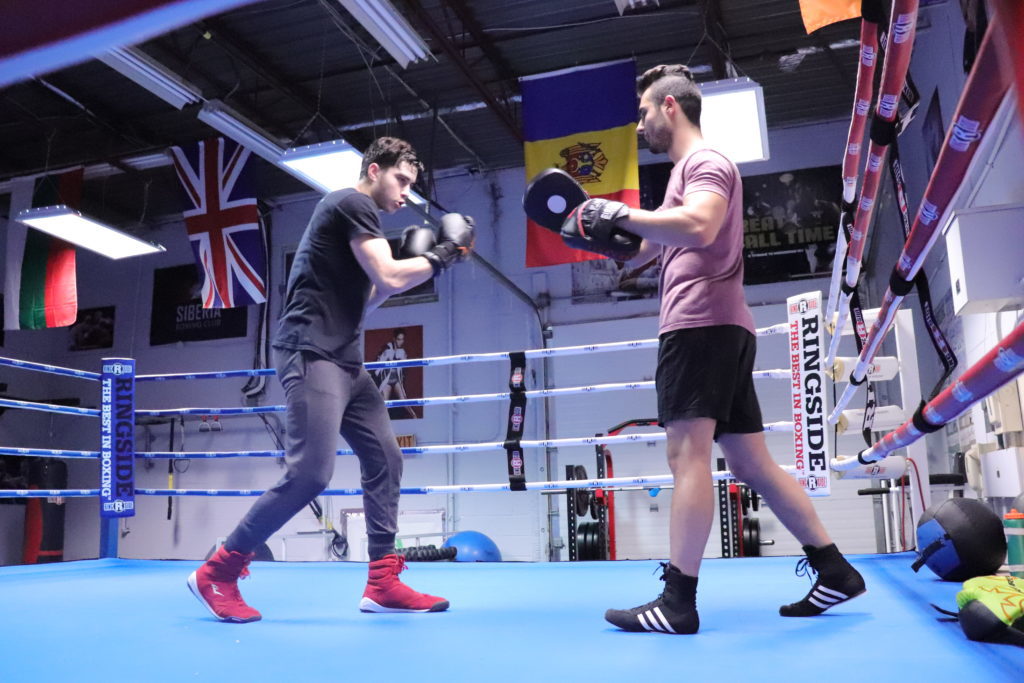
Boruch Rabiski (left), one of the more advanced fighters at Siberia Boxing Club, trains with his friend Samir Mamedov (rght). On Wednesday, March 4, 2020. (Adam Hostetler/T•)
The friendly environment does not translate into a forgiving workout. The glaring white lights above shine down on the members, who glisten with beads of sweat within minutes.
Photos of world-renowned boxers like Mike Tyson, Muhammad Ali and Floyd Mayweather encircle the training room. If this room were a boxing ring, the rows of iconic boxing images on the walls would be the ropes, ensuring that the sport never leaves the mind of any member.
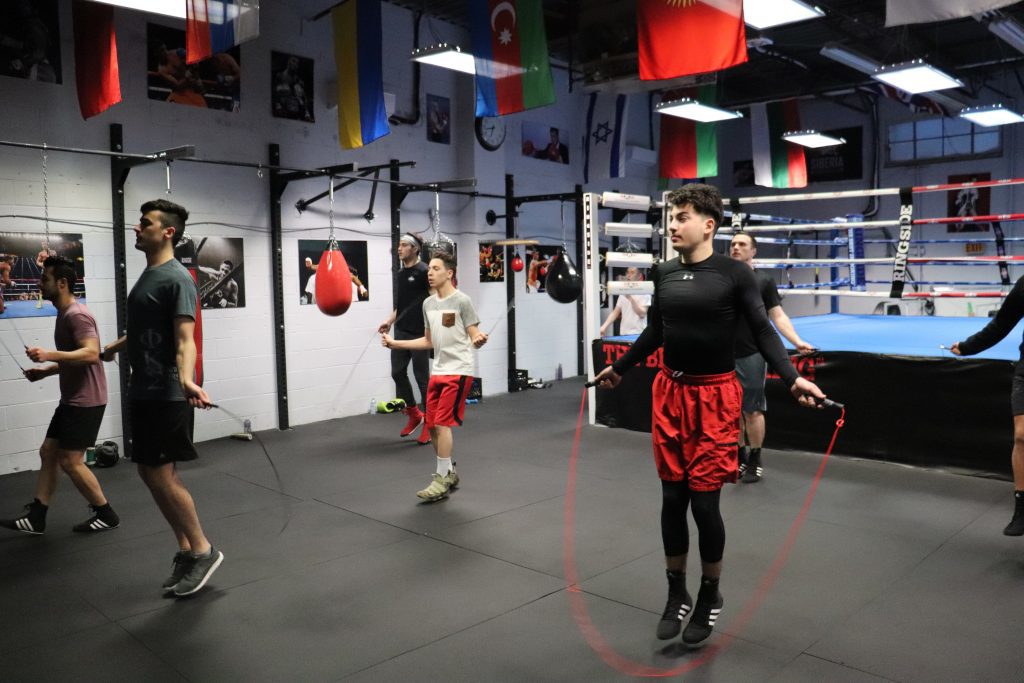
After the jogging warm up, the students begin jumping rope, a staple of boxing training. The exercise appears effortless for the students and they look as if they could go for hours.
On Wednesday, March 4, 2020. (Adam Hostetler/T•)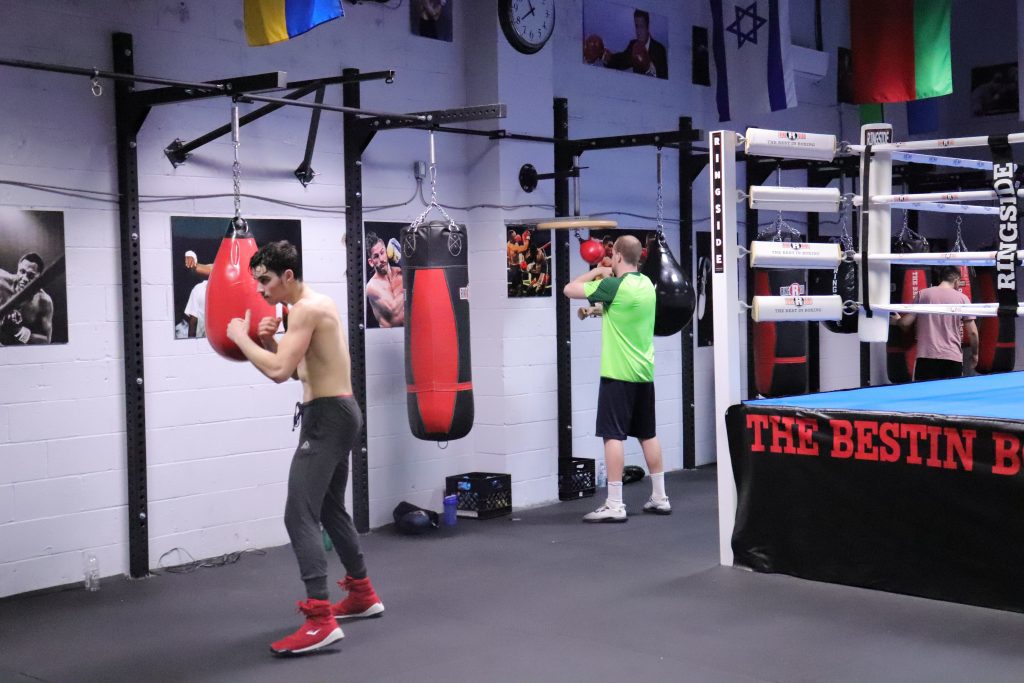
Boruch Rabiski continues to improve his technique while Ivan Yakovle works with the speedbag. This improves hand-eye co-ordination, quickness, defence and many other aspects of boxing.
On Wednesday, March 4, 2020. (Adam Hostetler/T•).
Even though he had years of experience as a boxing coach, Kim had to adapt to the Canadian market when he opened his gym. Canada is not nearly as competitive as Kyrgyzstan when it comes to boxing. “Back in the Soviet Union, the goal of being a boxing coach is that you’re going to coach them so they can compete and win.”
In Canada, it’s just not worth it to try chasing down that one special student. Kim had to convert his teaching skills from working with elite talent to working with anyone who signs up, and he says he enjoys both of these teaching styles equally.
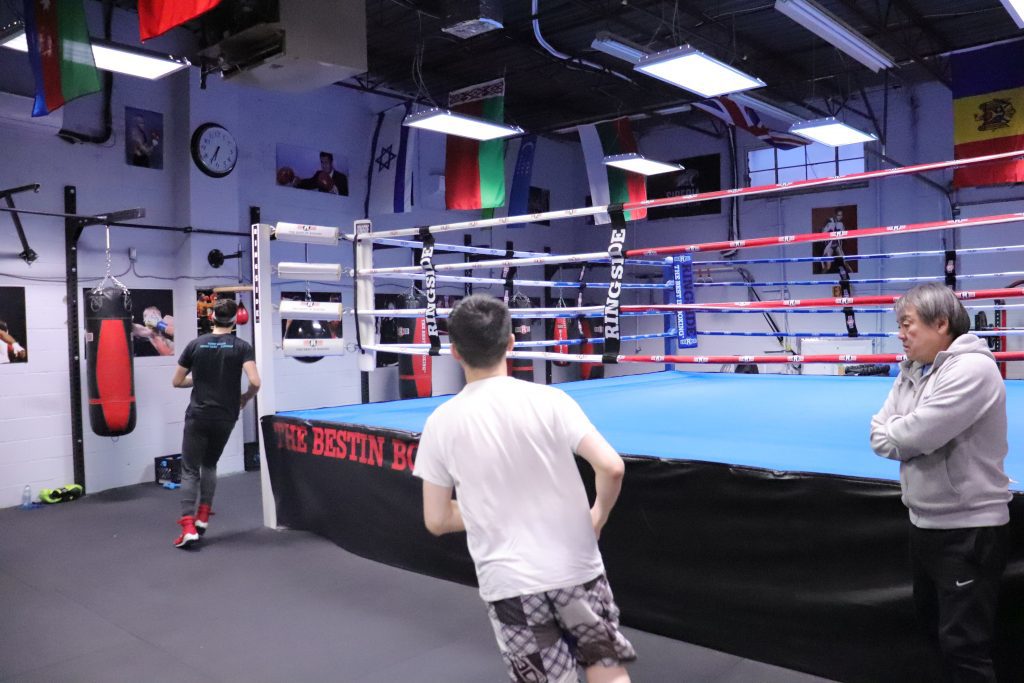
Viloryi Kim waits for the students’ warm up to conclude as they run laps around the confined open space. After their jog, they jump rope and commence boxing exercises.
On Wednesday, March 4, 2020. (Adam Hostetler/T•)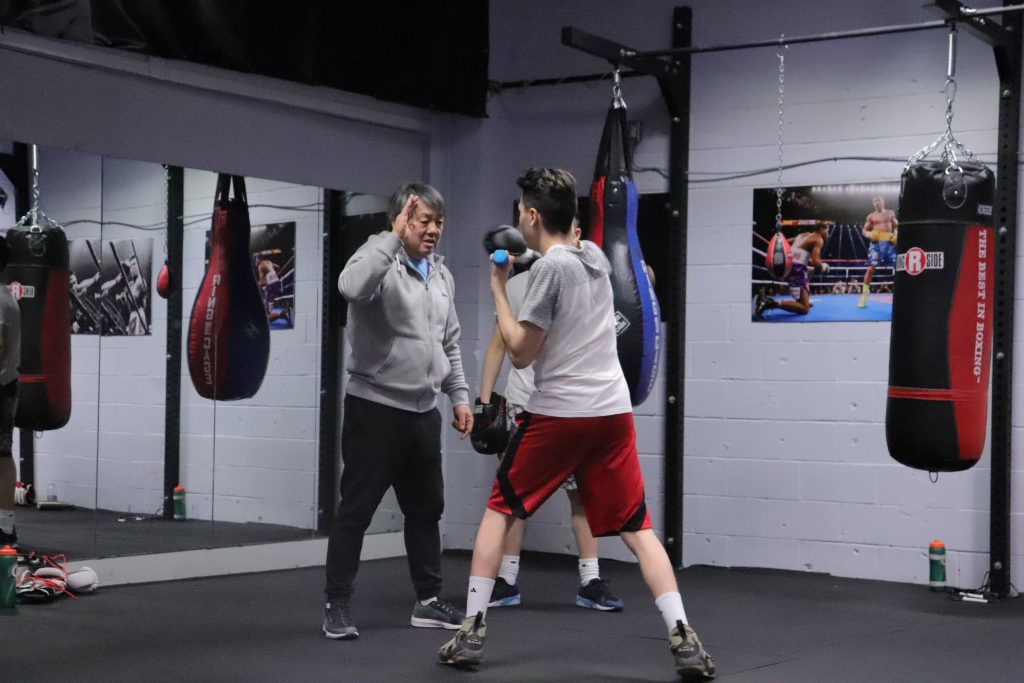
Viloryi Kim works with Anthony Lai and Stephan Soloman during a boxing pad workout. Kim takes as long as he needs to ensure his students know exactly what to do.
On Wednesday, March 4, 2020. (Adam Hostetler/T•)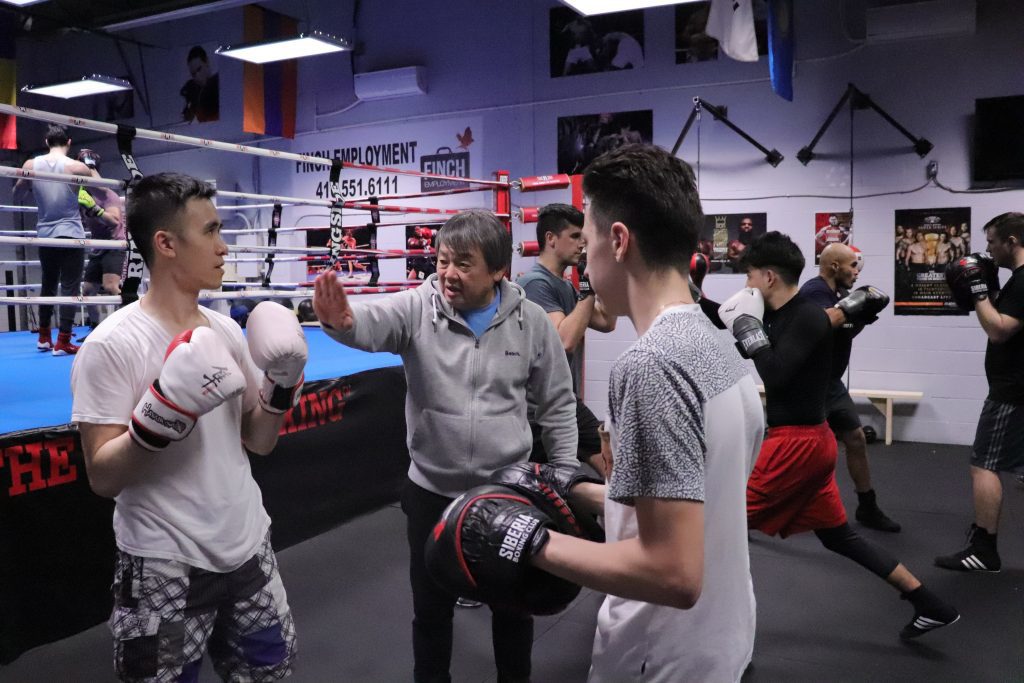
Coach Viloryi Kim shows Anthony Lai (left) and Stephan Soloman (right) the ideal form and technique for the exercise. The two listen attentively to their coach’s advice. On Wednesday, March 4, 2020. (Adam Hostetler/T•)
He moved to Canada with his wife, Aigul, and their daughter, Adele, who was only eight at the time. Like many immigrants, they came in search of better opportunities.
When they first arrived, Kim was working an office job. He had experience working in business back in Kyrgyzstan, but his poor English made the transition difficult. He went through two college programs in Canada – business administration and massage therapy.
“I don’t like to work as a massage therapist. Why I finished the program? I don’t know.”
Kim enjoys coaching far more than if he were working in an office, but there’s no job security or guaranteed income. He has seen many competitors open gyms, and nearly just as many close their doors.
“If you want to open a gym, I don’t recommend it. It’s not a good business.”
According to Kim, one of the most important things when establishing a gym is understanding how you can make money and how you can be better than other clubs. Before launching his own business, Kim would rent space in any gym that would give it to him and he’d teach boxing. His goal was to develop an understanding of what people want and then find his own way to give it to them. At Siberia Boxing Club he seems to have found the right mix.
The class draws to a close and some students find their own area to begin cooldown exercises. Others, like Rabiski, continue practising their punching proficiency, a few catch up with friends, or get in some final free weight reps before the next class starts.
The next group of students arrive at 8 p.m. and the warmup exercises begin. Kim instructs them to work on their punching techniques. After a minute, the red digital timer above the mirror reaches zero and shrieks like a smoke alarm once again.
